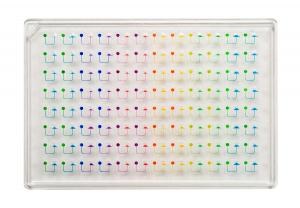
The Crystal Former is a microfluidic device for protein crystallization that exploits the favorable physical conditions occurring at the microscale. This environment, when combined with the Crystal Former's special materials, unique surface treatment, and proprietary mixing kinetics substantially improve crystallization success.
Each capillary's continuous gradient enables screening a vast nnumber of conditions, comparable to doing hundreds of individual experimetns using other technologies. This means more rapid identification of initial crystallization conditions and the identification of multiple crystal forms.
Key advantages:
High-output redefined-- Maximum crystallization probability on one plate
Simple to use, no external equipment is required, automatable, ready to add to any workflow
Low protein consumption
Direct Access to crystals for harvesting
What is high output crystallization?
Exemplified by the Microlytic SBS High Throughput Crystal Former, high output crystallization experiments are trials in which the number of crystallization events is generally large relative to conventional experiments. Such systems explore a much greater area of crystallization space with fewer discrete crystallization conditions and low protein consumption. As offered by the Crystal Former, ideal high output crystallization platforms also feature:
Increased probability of crystallization success
Systematic screening for which the output is easy to interpret and highly informative, even in the absence of crystals;
Non-redundant exploration of crystallization space
Easy integration into all structural biology platforms, including cross-platform robotic compatibility.
How does the Crystal Former return high output crystallization data?
The Crystal Former comprises 96 U-shaped channels in which protein crystallization is driven by liquid-liquid diffusion. The protein sample is first loaded into the channel, which fills only by capillary action. The crystallization reagent is then loaded into the opposing inlet. Equilibration of these solutions occurs through diffusion within the microchannels, during which a complex gradient of all the mixture components is transiently established. Through this gradient, the behavior of the protein target is explored with infinite sampling. This continuous exploration of crystallization space for a discrete condition is virtually impossible to capture in other crystallization formats and returns a tremendous amount of information on a per-trial basis, allowing the user to observe all possible experimental outcomes in a single microchannel.

Videos :
- Setup of the Crystal Former on the Mosquito:
- Crystal Former Storage:
- Crystal Harvesting from the Crystal Former:





